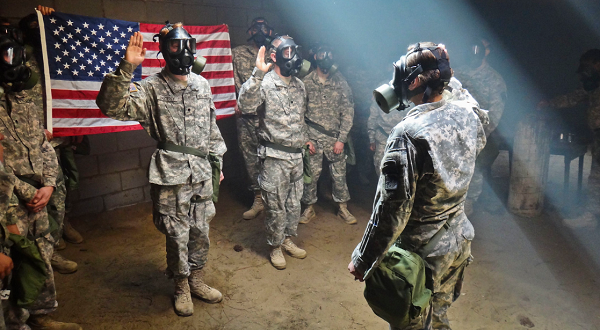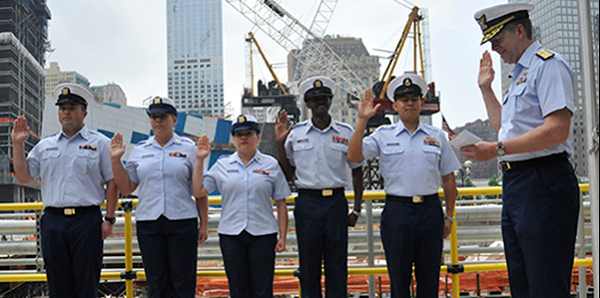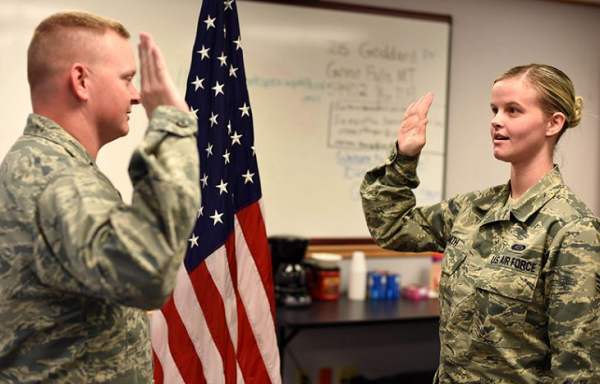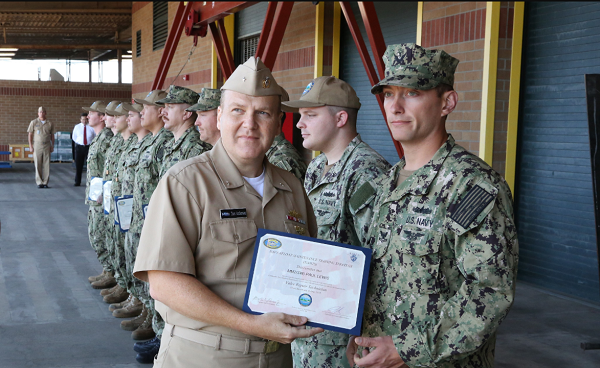A Reenlistment (RE) code is found on your discharge documents and describes your eligibility for re-enlisting.
RE codes are found on DD Form 214.
The code will state if an individual is eligible, needs a waiver, or is ineligible.
RE codes are given based on certain discharge scenarios and have different meanings across different branches.
U.S. Army RE codes generally follow a guideline of 1 being eligible to reenlist without issue, 2 being able to reenlist with restrictions that may apply, RE code 3, an individual can usually reenlist but a waiver may be required, and individuals with an RE code of 4 generally not able to reenlist (see FAQ section below).
The Air Force has a similar structure with individuals with a RE Code of 1 being able to reenlist, with a waiver sometimes needed.
Air Force RE Code 2 is generally not able to reenlist; RE Code 3, not eligible to immediately reenlist but may be eligible for prior service enlistment with waiver; and 4, unable to reenlist.
The Navy, Marine Corps, and Coast Guard allow individuals with a 1 to reenlist, 3 to reenlist with a waiver, and 4 not to enlist.
Use the guide below to find a complete list of reenlistment codes for each military branch and their descriptions.
Related Article –Dishonorable Discharge: Reasons, Consequences And More
Jump To A Section
U.S.Army Reenlistment Codes

RE-1– Individuals with this RE Code were fully qualified when separated and fully qualified for enlistment.
RE-1A– Individuals with over 6 years of service for pay, are fully qualified to reenlist after 93 days after the date of separation.
RE-1B– Individuals who have not been tested to verify primary MOS during the term of service, are fully qualified.
RE-1C– Individuals who tested prior to October 1, 1980, and do not have a 90 or higher in any 3 or more aptitude areas of the ASVAB or scores of 85 or higher in 3 or more ASVAB aptitude areas for those tested on or after October 1, 1980. Fully qualified provided otherwise qualified.
Related Article: 15 Best States For Military Retirees And Veterans
RE-2– Separated for Government convenience according to Chapter 5, AR 635-200 (Chapter 5, 6, 8, 9, 11, 12), fully qualified for reenlistment.
RE-2A– Individuals with 6 plus years of service for pay who have an additional service requirement, declined to meet the requirement through reenlistment or extension and were separated prior to August 15, 1977; fully qualify to reenlist after 93 days; ineligible to reenlist in grade.
RE-2B– Fully qualified when last separated but reenlistment not authorized at that time under enlisted year group management plan; fully qualified.
RE-2C- Fully qualified when last separated but reenlistment was not authorized at that time under reenlistment control policy; civilian-fully qualified for reenlistment.
RE-3- Individuals are not qualified for continued Army service, but the disqualification is waivable; Waiver must be granted to reenlist.
RE-3A- Section 1: For individuals who do not meet the minimum scores in any 3 or more AQB or ACB aptitude areas.
This code is no longer used; fully qualified if mental requirements can be met and waiver is approved for continuous, unbroken service for RA in-service personnel.
Related Article: Military Moral Waivers Explained
Section 2: Individuals with 6+ years of service for pay with additional service requirements who do not meet the additional service with reenlistment or extension and were separated on or after August 15, 1977, fully qualified; waiver is valid for continuous, unbroken service for RA in-service personnel.
RE-3B- Individuals who lost time during the last period of service; ineligible unless a waiver is granted; applicable to EM who have lost time.
RE-3C– 4 months+ of service completed who do not meet pay grade requirements or were denied under Qualitative Screening Process according to Chapter 4 AR 600-200; ineligible unless a waiver is granted; applicable to individuals with over 8 months of service and do not meet prior grade or service of the Qualitative Management Program Chapter 4 AR 600-200.
RE-4- Separated with a nonrecoverable disqualification; ineligible for reenlistment in most circumstances.
RE-4A– Eligibility citizen requirements not met when separated; ineligible for enlistment unless citizenship requirements are met.
RE-4R– Retired after 20 or more years of active Federal Service (Title 10, U.S. Code 3914 or 3917); Ineligible.
Related Article – How to Join the U.S. Military as a Non-Citizen
U.S. Navy Reenlistment Codes/ U.S. Marine Corps/ U.S. Coast Guard Reenlistment Codes

RE-1– Eligible
RE-1A– Eligible
RE-2– Ineligible; recommended for reenlistment but ineligible because of status: Fleet Reservist Retired, Commissioned Officer, Warrant Officer, Midshipman, Cadet.
RE-3A-Ineligible as non-citizen. May become eligible if citizenship requirements are met.
RE-3B– Pregnancy; parenthood; Restricted assignment
RE-3C– Conscientious Objector; ineligible for reenlistment unless a waiver is granted and authorized by CMC.
RE-3D– Individual failed to meet disciplinary standards, demonstrated dependency or hardship not meeting criteria, ineligible unless a waiver is granted.
RE-3E– Erroneous induction-education prerequisites not met; qualified if education criteria are met
RE-3F– Ineligible due to failure to meet physical fitness assessment.
RE-3G– Condition, not of a physical disability, interfering with the performance of duty
RE-3H– Hardship
RE-3K– Individual dis-enrolled from Navy Academy, not qualified for enlisted status
Related Article – The 20 Best Jobs For Veterans
RE-3M– Ineligible for reenlistment in member’s current rating or MOS.
RE-3N– National health, safety, or interest importance
RE-3P– Ineligible due to individual’s physical disability (includes discharge and transfer to TDRL).
RE-3R– Did not meet professional growth criteria; ineligible to reenlist without a waiver
RE-3S– Sole surviving family member
RE-3U– Minority age
RE-4– Not eligible for reenlistment
RE-5– USNR-R served 90 or more days of active duty and returned to the Reserve unit without reenlistment eligibility being determined.
RE-6– High-year tenure; ineligible or denied to reenlist
RE-7– Initial 2-year active duty obligation completed under 2×8 Navy Reserve Program
RE-8– For recruits assigned to Recruit Training for initial training who have temporary medical conditions or unsatisfactory initial performance and conduct.
Related Article – Military Jobs: A List of all 512 Jobs in the U.S. Military
U.S. Air Force Reenlistment Codes

RE-1A– Ineligible to reenlist, but the condition is waived
RE-1J– Eligible to reenlist, but elects separation
RE-1K– Career Airmen with 13 months or less remaining before completing 20 years
RE-1M– Second term or career airman; eligible to reenlist
RE-1P– Airman with extension of enlistment, second term or career airman with 19 years time of service and 13 months or less before original expiration of service; eligible to reenlist
RE-1Q– Career airman with 20 or more years of service and 13 or fewer months remaining before original expiration of service; eligible to reenlist
RE-1R– First-term airman selected for reenlistment
RE-1T– Voluntary or involuntary extended active duty airman; eligible to request enlistment
Related Article: 20 Reasons to Join the Military (and 7 reasons not to)
RE-2A– AFPC denied reenlistment
RE-2B– General or other than honorable conditions discharge
RE-2C– Involuntary honorable discharge or entry-level separation without service characterization
RE-2D– Returned prisoner with 6 months of active duty since return
RE 2E– Probation and rehabilitation period
RE-2F– Separated during rehabilitation in a DoD regional confinement facility
RE-2G– Completing or failed to complete the Alcohol and Drug Abuse Prevention and Treatment (ADAPT) program for drugs
RE-2H-Participating or failed to complete the ADAPT program for alcohol
RE-2I– Non-U.S. Citizen on initial enlistment
RE-2J– Individuals who are under investigation by the military or civilian authority and the result may end with a discharge or court-martial action
RE-2K– Initiation of involuntary separation action
RE-2L– Equivalent Courts-Martial charges pending in civilian court or court-martial action under review
RE-2M– Serving or suspended of a Courts Martial suspension
RE-2N– Conscientious objector whose religious convictions preclude unrestricted assignment
RE-2P– Absent without leave; deserter
RE-2Q– Medically retired or discharged
RE-2R– Within 23 months of 60th birthday, completed 18 years, one month or more of active service, and 13 months or less remaining
RE-2S– Within 23 months of 60th birthday, completed 18 years, one month or more of active service, and 13 months or more remaining
RE-2T– HYT date of 20 years and within 23 months of HYT date and 13 months or less remaining
RE-2U– HYT date of 20 years and within 23 months of HYT date and 13 or more months remaining
RE-2V– Airman applied for or has been approved for retirement
RE-2W– Retired and recalled to RegAF
RE-2X– First term, second term, or career airman non-selected for reenlistment
RE-3A– First-term airman separated before 36 months (60 months for 6-year) and has no disqualifying factors or ineligibility conditions; first-term female airman who was discovered to be pregnant before enlistment; first-term airman involuntarily separated for inability to progress in training or performance on duties
RE-3B– First term, second term, or career airman who was ineligible to reenlist but the condition no longer exists
RE-3C– First-term airman not yet considered under SRP
RE-3D– Second term or career airman who would not get PCS or TDY assignment retainability, declined retainability for deployment
RE-3E– Second term or career airman who refused to get retainability for training or retraining or declined to attend
RE-3F- Air Force Enlisted Retention Board selected airman for non-retention
RE-3I– First term airman selected under SRP without CJR awarded, removed from eligibility
RE-3K– Used by AFPC or AF Board for Correction of Military Records when no other reenlist code applies
RE-3Q– Air Force Quality Force Review Board selected airman for non-retention
RE-3S– Special Separation Benefit separation
RE-3V– Enlisted Voluntary Separation Pay Program or Voluntary Separation Incentive separation
Related Article: 6 Ways To Check If Someone Was In The Military
RE-4A– Hardship or dependency
RE-4C– Concealment of juvenile records, minority, failure to meet physical standards, failure to attain 9.0 reading grade level, void enlistments
RE-4D– SrA/E-4 with at least 9 years, but less than 16 years of TAFMS and not selected for promotion to SSgt/E-5
RE-4E– 4-year enlistee with A1C grade or below with 31 or more months completed and FTA or 6-year enlistee below SrA with 55 or more months completed
RE-4F– 5 or more days lost time (can receive waiver)
RE-4G– AFSC skill level is not commensurate with grade
RE-4H– Suspended punishment (Article 15, UCMJ) suspension being served
RE-4I– Serving on the Control Roster
RE-4J– Unsatisfactory fitness assessment
RE-4K– Pending evaluation from Medical Evaluation Board/Physical Evaluation Board
RE-4L– Officer Training School, Airman Education and Commissioning Program and similar programs eliminee
RE-4M– Breach of enlistment/reenlistment agreement
RE-4N– Civilian authority conviction
Related Article – Air Force Aerospace Ground Equipment (2A6X2): Career Details
Frequently Asked Questions (FAQ)
Can you reenlist with anything other than an honorable discharge?
There are 5 types of military discharges.
The types of discharges include Honorable, General (Under Honorable Conditions), Other Than Honorable, Bad Conduct Discharge, and Dishonorable Discharge.
Some sources count Entry Level Discharge or Uncharacterized Discharge as another type of discharge, bringing the total to 6.
Entry Level Discharge or Uncharacterized Discharge, occurs when soldiers are discharged within the first 180 days of enlistment for a variety of reasons.
Depending on the RE code and Separation Code, you may be eligible to reenter with a waiver.
General (Under Honorable Conditions) can occur for many reasons, such as drug abuse.
Other Than Honorable Discharge is usually given for administrative separation.
The Air Force lists General and Other Than Honorable as not eligible to reenlist.
However, other branches may allow you to reenlist with a General (Under Honorable Conditions) or Other Than Honorable, depending on the RE code.
Bad Conduct Discharge and Dishonorable Discharge are given after a court-martial proceeding, and one can generally expect not to be able to reenlist with these discharges.
What are some other factors that can affect your reenlistment eligibility?
Your reenlistment eligibility can be affected by the character of service and separation code.
To have the best chances of reenlistment, an individual should have an honorable discharge listed as the character of service.
The separation code describes the reasoning for separating from Military service such as entry-level performance or parenthood.
Having a positive separation code can affect your reenlistment eligibility.
Other factors that may affect your reenlistment eligibility are if your MOS is open, if you still meet requirements (physical, age, etc), and discharge characterization.
Related Article- Sirius XM Military Discount
Can you upgrade a military discharge?
It is possible to upgrade your military discharge.
You may want to do this to help with reenlisting, or because it has an effect on civilian circumstances such as VA benefits.
Upgrading a military discharge is not easy, but can be done with enough supporting documentation.
You must prove that your discharge was erroneous, untrue, unfair, or based on false information by proving information to support the discharge was inequitable or improper.
Usually, individuals have 15 years from the date of discharge to apply with their branch-specific Discharge Review Board.
After 15 years, individuals must apply for a correction of military records.
The Discharge Review Board can review cases that are not a result of a General Court-Martial and applications are reviewed, not automatic.
Recently, the Department of Defense and the VA launched a tool that assists veterans in applying for an upgraded military discharge or a change in discharge characterization.
What is an RE 4? Can it be changed?
An RE 4 is a reenlistment code that states individuals are ineligible to reenlist and are generally not eligible for a waiver.
An RE 4 can be given for a variety of reasons and can have a few different specific codes, depending on the branch.
The reasons RE codes are given can include retirement after 20 years, breach of agreement, or simply not being recommended for reenlistment.
An Army RE code can only be changed if evidence is provided that shows the RE code has an error or is unjust.
When submitting a request to update a military discharge, the Discharge Review Board will also review whether a RE Code should be upgraded.
Most times, an RE 4 cannot be changed, and an individual will have to submit a waiver to reenlist into a military branch.
Related Article – Military Alphabet: Printable PDF, Flash Cards, Chart, and Quiz
Conclusion
Reenlistment codes are vital to understanding your eligibility to return to service.
Each military branch has different reenlistment codes and definitions.
Reenlistment codes are found on discharge paperwork and describe reasons for discharge.
RE codes can only be changed in the event of an error or during other scenarios such as during an upgrade discharge review.
The separation code and military discharge can also play a factor in your ability to reenlist.
It is best to leave the military with an honorable discharge.
But in the event that this does not happen, it is possible to reenlist or even apply to have your discharge upgraded.
References
- Replacing Dog Tags: 6 Things You Need to Know - June 28, 2024
- Navy OAR Test Study Guide - June 24, 2024
- 10 Best Sniper Movies of all Time - June 20, 2024
General FAQ
Can I reenlist with an RE 4 code?
With an RE 4, you would normally not be eligible to reenlist or join another branch of the service. It would require an Exception to Policy waver to reenlist.
Can you reenlist after a general discharge?
While a bad conduct or “other than honorable” discharge might prevent you from reenlisting, a general discharge would likely allow you to reenlist, depending on the branch of service.
What Army RE codes will let me reenlist?
After discharge, an RE code of RE-, RE-2, or R-3 may reenlist after certain conditions are met. You may need a waiver or require a waiting period.
What is an RE-8?
RE-8 is a Navy reenlistment code indicating that the recruit developed a temporary medical condition or poor performance in boot camp.
Where do I find my reenlistment code?
You’ll find your RE code on your DD Form 214, and it will denote the character of your discharge and whether or not you’re eligible to reenlist.

